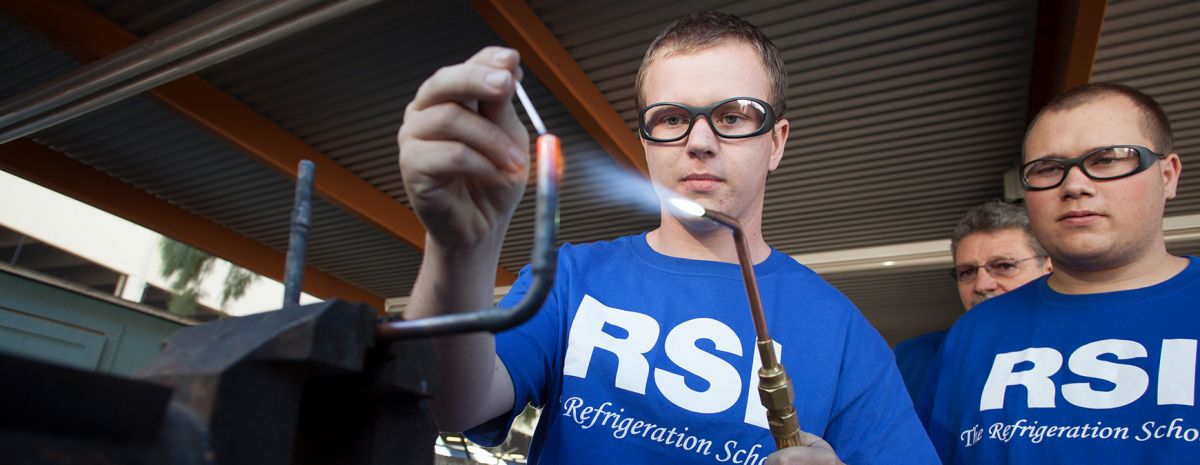RSI is a Great Training Option for Everyone
Learn more about how we can prepare you to advance your career.
The COVID-19 pandemic had negative consequences in the realm of work and education.1 Millions of U.S. adults had their academic and professional plans disrupted, with marginalized groups being disproportionately affected.1
This unforeseen and drastic shift created some changes in terms of educational choices. Colleges saw a severe drop in enrollment, while trade school training is seeing continued interest among those looking to further their education.1
Here, we’ll take a look at whether or not a college education is still valuable, how the pandemic has changed people’s views, and why trades programs, such as HVAC training, can offer a viable alternative to 4 years of university.
Is a College Education Valuable?
It’s been the prevailing perspective that a college education is the path to the American Dream. However, many people aren’t seeing the connection between a four-year degree and a fulfilling career, causing some to wonder if college is even all that valuable.
Why has the value of college decreased in some people’s eyes? Over the past few decades, the increasing price of tuition has made it harder and harder for individuals to afford higher education as it outpaces both inflation and family income.2 This barrier can greatly limit the number of people able to reap the rewards of a college education.
Get Started on the Path to a New Career
Fill out our form to learn how we can help you change your life.
Most recently, the stressors related to the COVID-19 pandemic have also contributed to a shift in the perceived value of a college education.2
How the Pandemic Disrupted Academic Plans
In addition to being a major health crisis, the COVID-19 pandemic represented an unprecedented disruption in work and education across the economy: more than 50% of U.S. adults suffered a change in their work in some way due to the pandemic, according to the Strada Center for Education Consumer Insights 1 On the academic front, over 33% of adults had to adjust their plans or cancel their education altogether.1
The two most commonly cited reasons for changing academic plans were cost burdens and the need to work.1 Although these numbers are alarming, a silver lining is found in the increased motivation to return to school among adults whose work was disrupted. In fact, over 37% of adults are intending to enroll in some form of education within the next six months.1
How the Pandemic Shifted the Perception of College
The sheer disruption caused by the pandemic has led many people to view college very differently than before. A StrataTech survey reporting on how people view college post-COVID found 59% of respondents believe that a bachelor’s degree is necessary to land a good job.3 This number is down from 70% just a few years prior.3 Similarly, only 61% see a four-year degree as a worthwhile investment, which represents a more than 15% drop from 2019.3
The pandemic might have been the catalyst behind the most recent drop in college enrollment, but there are myriad reasons behind the shift. Another report by the Strada Center for Education Consumer Insights combining the expertise of dozens of educational experts revealed some of the top reasons adults were deciding not to enroll in college:
- Financial pressures
- Lack of connectivity between degree and employment
- Uncertainty about the value of college education
- Discomfort with online learning4
The Skilled Trades Can Offer a Promising Alternative to College

At the same time college enrollment is experiencing a major dip, interest in nontraditional learning options, such as the skilled trades, remains high.1 In fact, the StrataTech survey reveals that 57% of those currently enrolled in or thinking of enrolling in the skilled trades were motivated to do so by the pandemic.3 Of the respondents who were still in high school, 80% view the skilled trades positively.3
Here are just a few reasons why people are making the switch and why the trades can be a promising alternative to college.
Less Financial Burden
When trying to pinpoint the main drivers behind the decrease in college enrollment, Strada found that the financial burden of a four-year degree was the primary culprit.4 The Institute for College Access & Success revealed the average college graduate has a whopping $28,950 in student debt.5
Students looking to avoid that financial stress while still receiving a competitive education can turn to the trades, where the average student debt among graduates can be less than that of a college graduate.6 There are even financial aid opportunities for students interested in the trades.
Quicker Path to Work
Another factor causing people to forgo a four-year education is a disconnection between degree and employment.4 While many bachelor’s degrees provide individuals with general knowledge in a field, trade school programs can equip students with the skills and know-how for a specific career. Plus, the trades can offer a quicker transition from education to employment, with trade school programs lasting between a few months and two years.
Essential Worker Status
The nationwide unemployment rate skyrocketed to record levels during the pandemic, reaching 14.8% at the worst point.7 With millions of people being furloughed or laid off completely, many were motivated to find pandemic-proof job opportunities in positions considered “essential.” In fact, the StrataTech survey found that 29% of those enrolling or considering enrolling in a trade school program were interested in becoming essential workers.3
Take the First Step Toward Trade School
If you’re interested in returning to school to learn a skilled trade like HVAC, welding or electrical wiring, contact The Refrigeration School to learn more about our training programs. Call 866-820-0823.
Additional Sources
1https://cci.stradaeducation.org/pv-release-may-19-2021-back-to-class/
2https://www.cnbc.com/2021/03/14/fewer-kids-going-to-college-because-of-cost.html
3 https://stratatech.com/wp-content/uploads/2021/10/2021-StrataTech-COVID-19-Pandemic-Survey.pdf
4https://stradaeducation.org/report/reconnecting-hs-experts/
5https://ticas.org/affordability-2/student-aid/student-debt-student-aid/student-debt-and-the-class-of-2019/
6http://www.collegescholarships.org/loans/average-debt.htm
7https://fas.org/sgp/crs/misc/R46554.pdf
This blog has been labeled as archived as it may no longer contain the most up-to-date data. For a list of all current blog posts, please visit our blog homepage at https://www.rsi.edu/blog/




